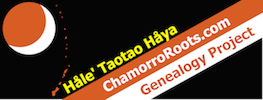
KA NONANONA. Buke 2, Pepa 12, Aoao 57. Novemaba 8, 1842.
MOKU POINO
I ka 25 o Ok. iho nei, ku ka moku okohola, o Geoki kona inoa, he moku Amerika, ma Waialua; no kona pilikia loa kona ku ana malaila. Eia ke ano o kona pilikia, i ka la 13, o Aperila holo mai na moku nei mai Guama mai, e imi kohola ana ma ka moana; he hapa ka ai maka maluna iho, a he nui na kanaka. Holo no a i ka malama o Augake loohia ua moku la i ka mai, he mai moku, he lolo, a make koke kekahi luina i ka la 11 o Sep. a mahope iho pau loa lakou i ka mai, a make loa ke Kapena, o Lake kona inoa, a me na luina eha, a ku ka moku ma Waialua make ka malama moku, a ua kanuia mauka. No ka hapa loa o ka ai maka keia poino ana. Ua lilo ua moku la i ke Kapena hou, a ua laweia mai i Honolulu nei. Ua pau ka nui o na luina i ke ola; elua wale no koe. He nui ko laua mai.
=====
Synopsis:
This is the earliest dated article I’ve found thus far in the Hawaiian language newspapers which mentions Guahan. Guam, in the Hawaiian language, is written here as Guama. The above article comes from the newspaper Ka Nonanona, dated November 1842. This is a first-hand account of an American whaling ship named Geoki (or George) that left Guam on April 13, 1842. An illness overcame the crew around August after the ship had been hunting whales for several months. By September, people were dying. On October 25, the ship anchored at Waialua on the North Shore of O’ahu, and the dead were buried upland. Since the Captain died, a new captain had to take over, and in the end, only 2 crewmembers survived. It is explained that the raw food on board is what made everyone sick.
Context:
After discussing this with my colleagues Keoni Ezell and Kaleo Kaho‘onei, Kumu Keoni pointed out something important that hadn’t crossed my mind. Food on board ships would be preserved in either salt or vinegar. For reasons unspecified in the article, a good portion of the food on this ship remained raw, and that led to the calamity.
Further Inquiry:
What amount of whaling ships came to the Marianas from America? What about whaling ships in the Marianas from other countries? Did the interaction of these whaling ships in the Marianas differ according to their country of origin? And what exactly did these ships bring to the local economy? Are there specific ways that the whaling industry left a legacy on the traditional Chamoru lifestyle?
Our Chamoru ancestors were very much tuned in to the natural environment, and this included both land and sea. There is no doubt that they were well aware of whales despite the meager mention of it in the earliest written records. How did whales figure into the Chamoru culture and beliefs about the natural world? What about the introduced concept of killing animals (whales) for money? And indeed, it was an introduced capitalist concept to hunt whales for other people. How did this imprint upon the Chamoru world view, both within the Marianas and outside the archipelago?
And regarding the native Chamorus, what amount ended up on these ships? Was it the norm? Was it the exception? To what extent did these Chamorus have agency in a society that was traditionally very family oriented and communal? Was approval from the village manamko or the immediate family needed? Was a blessing from the Catholic priest sought? To what extent did the Spanish governor or other Spanish officials exercise authority to “call all the shots” during this time period?
Finally, in what ways did the whaling era help to leave a Chamoru impact in other lands? We hear of Chamorus in the 1800s living in Hawai‘i, in England (recalling the Manibusan story in England), and elsewhere. Uncle Bernard also mentions the Custino brothers who were whalers living in Hawaii and returned back to Guam; and the Paris family name of Hawai‘i which came from the Perez family name in Guam. What amount of these resettled Chamorus were the direct result of whalers settling elsewhere? Could there be other sources that help clearly document the mobility of 18th century/19th century Chamorus across the Pacific and around the world?
All of these stories and more tie back to our family roots and our connections as native people of the Mariana Islands.
(Hawaiian Translation Project)

